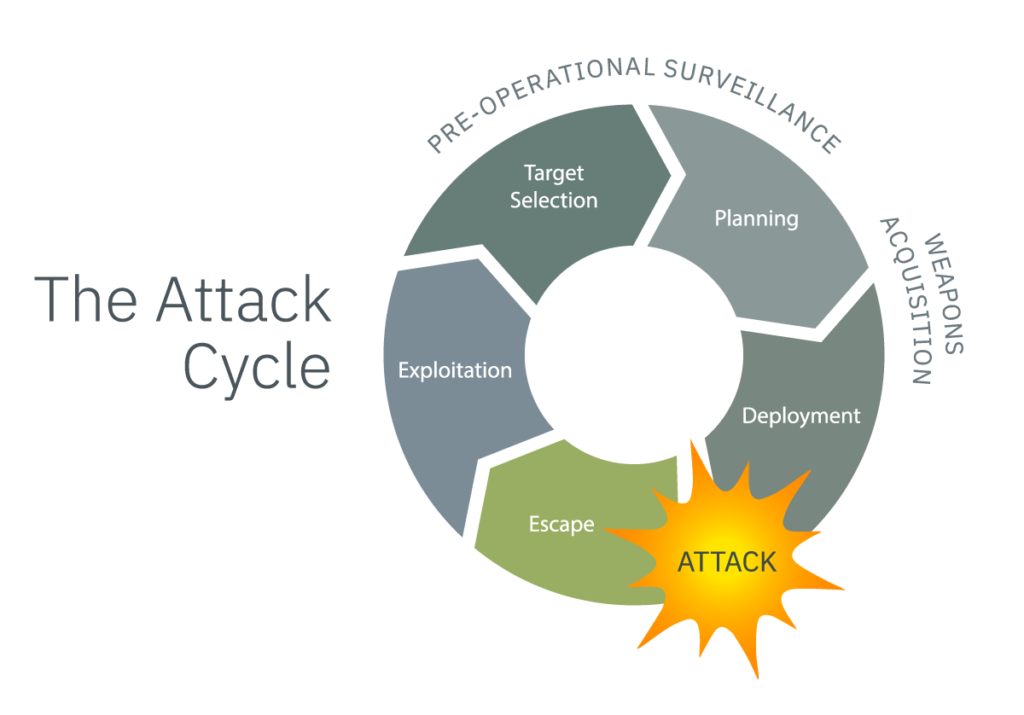Surveillance Detection: You Can’t Find Surveillance Unless You’re Looking For It

I learned surveillance tradecraft the hard way in the 1980’s, as chronicled in my memoir Ghost: Confessions of a Counterterrorism Agent (Random House, 2008). The course of history has been altered with significant protective intelligence failures and tragedies, from assassinations to school shootings, many caused by failing to notice or act on hostile surveillance. The sad reality is this: most victims rarely know if they are being watched until it’s too late. Once the actor with ill intent has walked down the pathway toward violence and arrived at the target location, the attack is hard to stop.
For a stalker or assassin to be successful, they must study and observe their target, an action that makes them vulnerable to surveillance detection. The challenge is seeing the surveillance taking place.
To stop an attack from occurring, you need to disrupt the attack cycle and one of the best ways to disrupt the attack cycle is to catch the actor at the point in the attack cycle where they are most vulnerable to detection: during the pre-operational surveillance phase of the attack cycle. Surveillance detection programs, augmented by technology, can be used to identify fixated behaviors and operational acts during the planning stages of an attack.
After a lifetime of examining successful and failed attacks, I’ve determined there are two critical components to understand. The first is the attacker’s motive, or the “why” behind the attack. The motive is important for the investigators to figure out and for analysts to ponder, but knowing the motive does little to stop an attack from occurring.
The second component is the attacker’s method of surveillance and attack, or the “how” behind the attack. The method and means of surveillance used by the attacker are critically important because understanding how surveillance takes place allows you to look for similar actions. Every attacker, stalker or criminal watches their targets, so it’s important to know what those actions are likely to look like and understand the geographic locations where you would be most likely to encounter them. The challenge is seeing the surveillance taking place.
Surveillance Detection Basics
So, how do you look for surveillance? First, you can’t find surveillance unless you are looking for it. In concept, this is a simple and practical idea, but on the streets, standing post, or while protecting an estate, it is hard to know what to look for. Technology solutions can help augment the human eye and mind, but these skills can also be taught.
When I teach surveillance detection skills, I use three key concepts:
- Mindset
- Observation Skills
- Pattern Analysis
Mindset: To start, In order to look for things that don’t fit, you need to know what fits. Study your geography, know your street, block and neighborhood, and develop a baseline of normalcy. Once that baseline is established, anomalies will stand out—you’ll notice a stranger lurking, a suspicious van, or vehicles driving slowly or perched as observation platforms. Own your geography and know what is out of place. It is also imperative not to have a mindset of complacency, with a sense that nothing can ever happen. Don’t get complacent about your normal surroundings.
Observation Skills: You can learn to see better. How? Practice. Many years ago, I took a course given by one of the alphabet soup agencies that showed how much we needed to learn about observing the world around us. It was embarrassing and eye-opening (pardon the pun) for a classroom filled with special agents, security and protection officers. The instructor flashed a quick image onto a big screen and asked us to describe what we saw. Invariably, everybody got it wrong. You can begin to get it right by practicing your observation skills in the world around you. For example, some of the most sophisticated surveillance teams in the world once worked from rooftops, but most people never think to observe what is happening above them. Why? Humans rarely look up, unless you hear an aircraft. Now, the same concept exists in drones and surveillance cameras. Observation and counter-surveillance skills take practice, patience and awareness.
Pattern Analysis: Look for abnormal or unusual patterns of activity in your everyday life, especially in locations you visit often where an attacker might try to surveil you. The key here is heightened situational awareness on your first move of the day. When you depart your residence, take a mental snapshot of the people, faces and cars that you observe. Later, if you see the same person or vehicle over a period of time and distance, you’ll know someone could be watching.
Here’s an example: You leave your house in the morning and see a blue van across the street. Then you drive to work. When you leave work later the same day, you see the same blue van outside of your workplace.
The blue van was observed over time—first during the morning departure and later in the evening departure—and distance—first at your home, then at your workplace. Nation-state surveillance teams never let you see the same person, vehicle, or bicycle more than once. Criminals or stalkers rarely have those resources, so the advantage is on your side, but only if you are looking. Once again, technology can help make sense of the behaviors captured, such as multiple surveillance drives near an estate or multiple passes over time.
Surveillance Detection Exercises
There are a few simple practices that will help you begin to hone your surveillance detection skills. One simple exercise you can incorporate into your daily routine to smoke out surveillance is called a Surveillance Detection Route or SDR. An SDR is used to determine if anyone is following or watching by using a series of simple directional changes.
Here we go. Walk or drive down Main Street, make a left on 1st Street, then make a right on 2nd Street. Stalkers or attackers will not want to lose the eye, so they will stay with you. Is anybody with you? Did you notice the same car behind you? If not, you are clean.
You can string the stair-step out over distance if you are driving, or by the block if you are walking. If you see the same person, car or bike behind you after your turns, you could be under surveillance. Coincidences can happen, but not in the world of surveillance.
A second practice you can implement is improving your memory skills. Sometimes the old school tricks are the best ones. You can learn to enhance your memory skills by observing license plates and people. This takes practice. Start by randomly observing license plates in front of you while in traffic, then elevate your game by trying to see if you can decipher plates through side view mirrors (hard to do). Stare at the license plate, close your eyes briefly, and you should have a mental snapshot of the numbers and letters. Keep a notepad handy or use the voice record feature on your mobile phone, just in case. Another exercise is to observe people and try to describe them based on the features of celebrities or well known personalities. For example, if I say that the person looks like Tom Cruise or Brad Pitt, everybody has a mental picture of who that might be. It helps when trying to reconstruct surveillance and aids with identification.






